Marketing Management: Report on New Zealand Tourism Strategy Analysis
VerifiedAdded on 2023/06/03
|23
|5866
|458
Report
AI Summary
This report analyzes the marketing management of New Zealand's tourism sector, examining its current strategy for branding and positioning as a tourist destination. It begins with an executive summary, followed by a situational analysis including SWOT and PESTEL analyses, and a literature review. The report evaluates the country's tourism, addressing environmental challenges, employee shortages, pay issues, cost increases, and access limitations. It proposes recommendations such as extensive marketing activities, segmentation and targeting strategies, diversified offerings, positioning and branding strategies, and market penetration. The report concludes with a discussion of the potential for enhancing the tourism strategy and includes references to support the analysis.
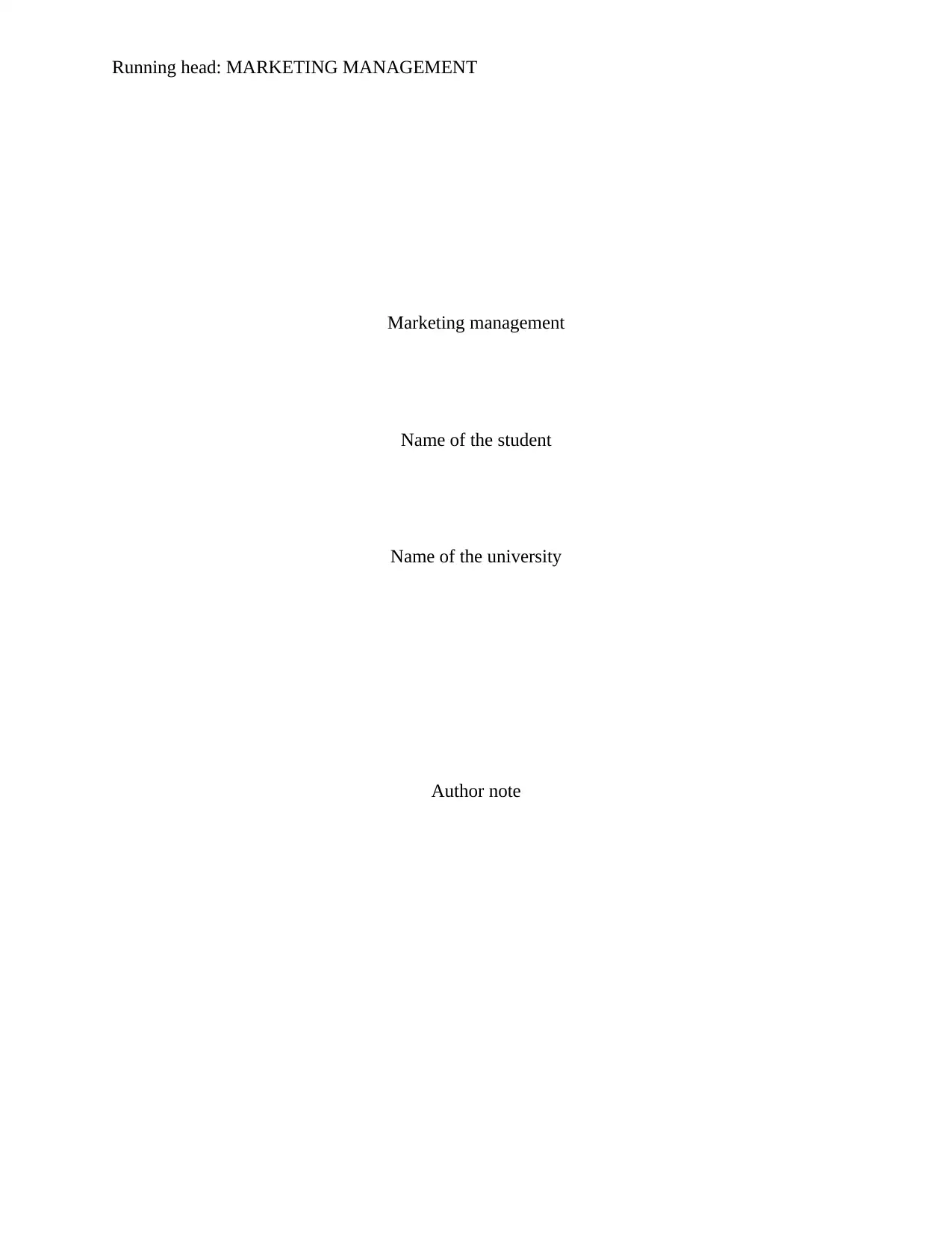
Running head: MARKETING MANAGEMENT
Marketing management
Name of the student
Name of the university
Author note
Marketing management
Name of the student
Name of the university
Author note
Paraphrase This Document
Need a fresh take? Get an instant paraphrase of this document with our AI Paraphraser
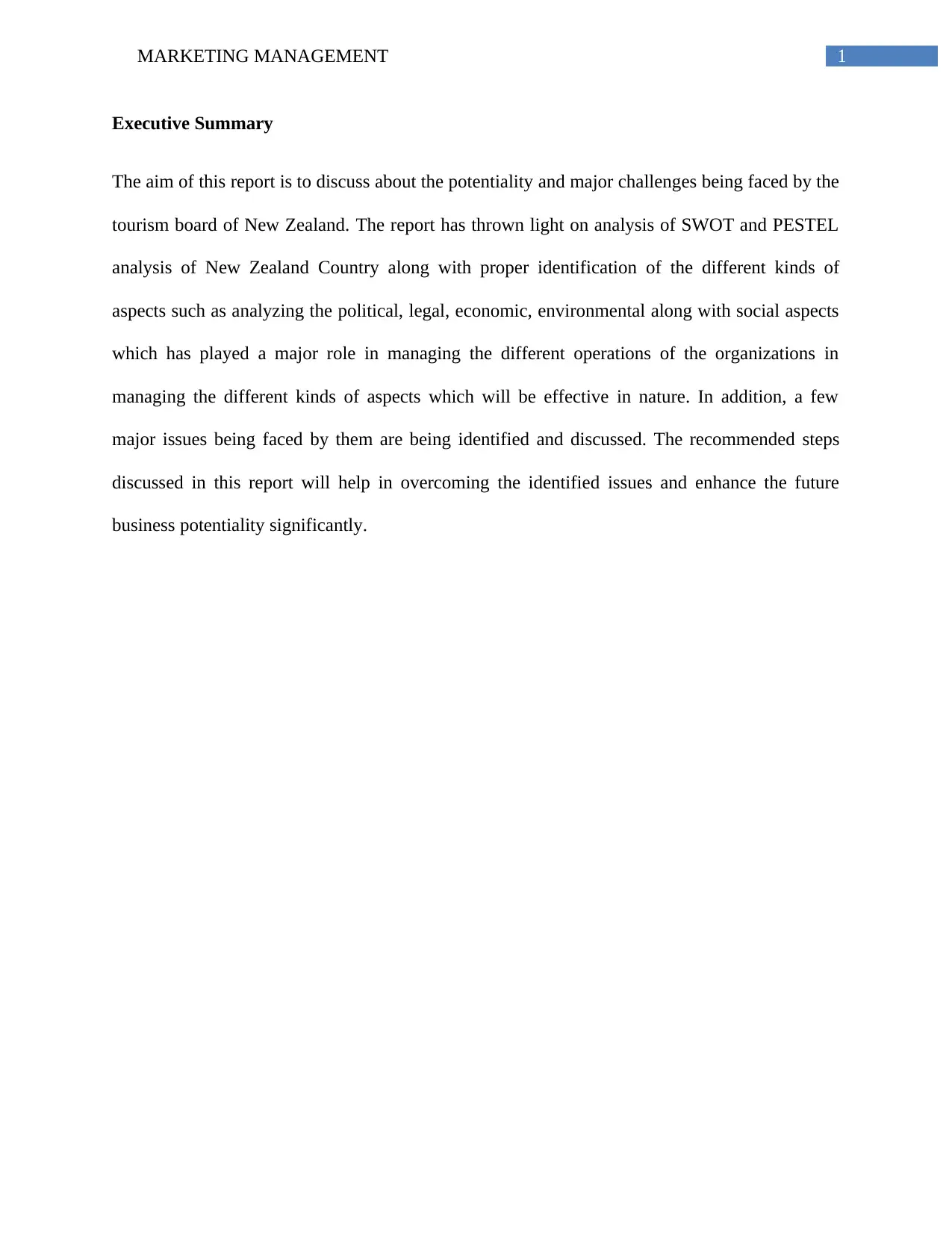
1MARKETING MANAGEMENT
Executive Summary
The aim of this report is to discuss about the potentiality and major challenges being faced by the
tourism board of New Zealand. The report has thrown light on analysis of SWOT and PESTEL
analysis of New Zealand Country along with proper identification of the different kinds of
aspects such as analyzing the political, legal, economic, environmental along with social aspects
which has played a major role in managing the different operations of the organizations in
managing the different kinds of aspects which will be effective in nature. In addition, a few
major issues being faced by them are being identified and discussed. The recommended steps
discussed in this report will help in overcoming the identified issues and enhance the future
business potentiality significantly.
Executive Summary
The aim of this report is to discuss about the potentiality and major challenges being faced by the
tourism board of New Zealand. The report has thrown light on analysis of SWOT and PESTEL
analysis of New Zealand Country along with proper identification of the different kinds of
aspects such as analyzing the political, legal, economic, environmental along with social aspects
which has played a major role in managing the different operations of the organizations in
managing the different kinds of aspects which will be effective in nature. In addition, a few
major issues being faced by them are being identified and discussed. The recommended steps
discussed in this report will help in overcoming the identified issues and enhance the future
business potentiality significantly.
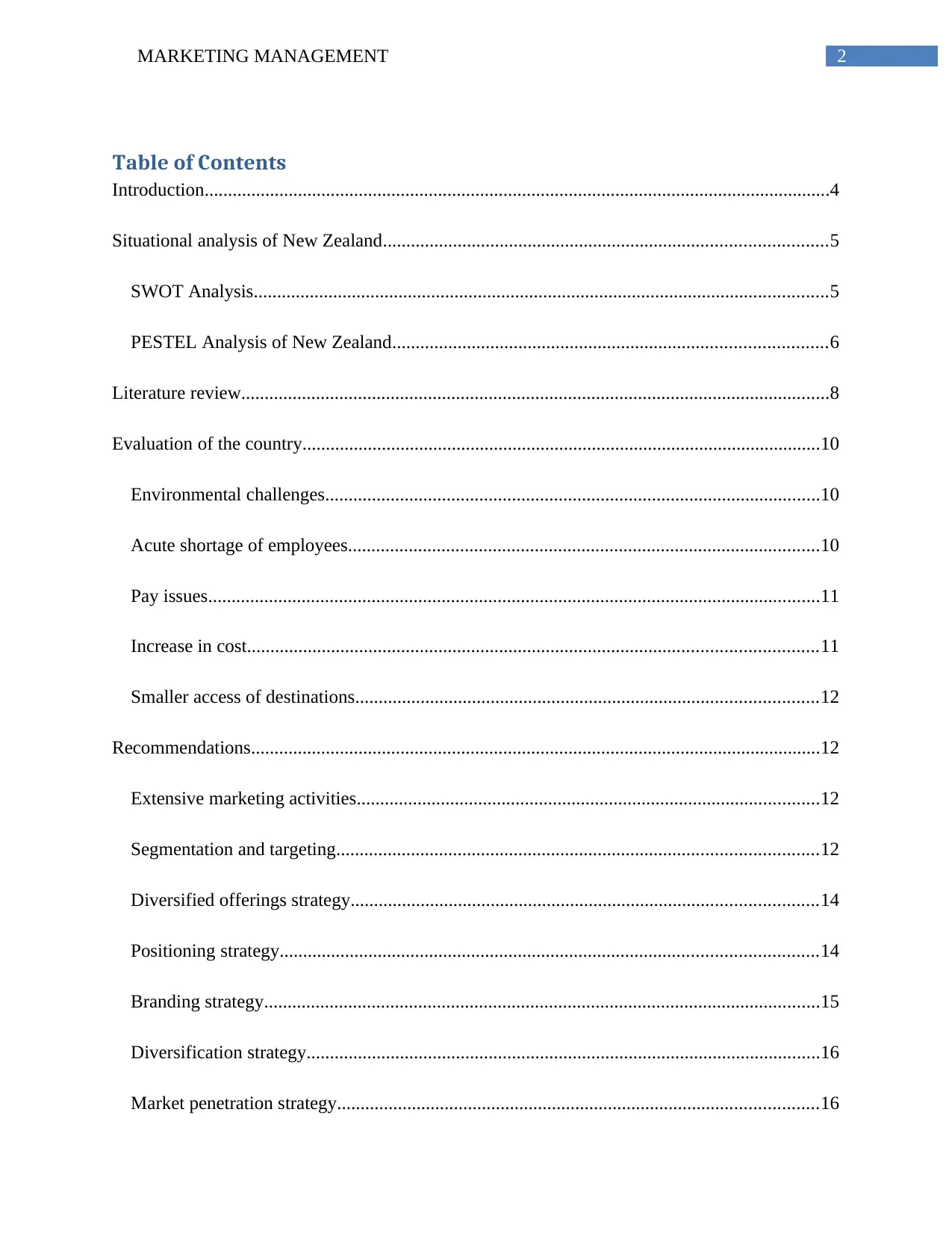
2MARKETING MANAGEMENT
Table of Contents
Introduction......................................................................................................................................4
Situational analysis of New Zealand...............................................................................................5
SWOT Analysis...........................................................................................................................5
PESTEL Analysis of New Zealand.............................................................................................6
Literature review..............................................................................................................................8
Evaluation of the country...............................................................................................................10
Environmental challenges..........................................................................................................10
Acute shortage of employees.....................................................................................................10
Pay issues...................................................................................................................................11
Increase in cost..........................................................................................................................11
Smaller access of destinations...................................................................................................12
Recommendations..........................................................................................................................12
Extensive marketing activities...................................................................................................12
Segmentation and targeting.......................................................................................................12
Diversified offerings strategy....................................................................................................14
Positioning strategy...................................................................................................................14
Branding strategy.......................................................................................................................15
Diversification strategy..............................................................................................................16
Market penetration strategy.......................................................................................................16
Table of Contents
Introduction......................................................................................................................................4
Situational analysis of New Zealand...............................................................................................5
SWOT Analysis...........................................................................................................................5
PESTEL Analysis of New Zealand.............................................................................................6
Literature review..............................................................................................................................8
Evaluation of the country...............................................................................................................10
Environmental challenges..........................................................................................................10
Acute shortage of employees.....................................................................................................10
Pay issues...................................................................................................................................11
Increase in cost..........................................................................................................................11
Smaller access of destinations...................................................................................................12
Recommendations..........................................................................................................................12
Extensive marketing activities...................................................................................................12
Segmentation and targeting.......................................................................................................12
Diversified offerings strategy....................................................................................................14
Positioning strategy...................................................................................................................14
Branding strategy.......................................................................................................................15
Diversification strategy..............................................................................................................16
Market penetration strategy.......................................................................................................16
⊘ This is a preview!⊘
Do you want full access?
Subscribe today to unlock all pages.

Trusted by 1+ million students worldwide

3MARKETING MANAGEMENT
Conclusion.....................................................................................................................................16
Reference.......................................................................................................................................18
Conclusion.....................................................................................................................................16
Reference.......................................................................................................................................18
Paraphrase This Document
Need a fresh take? Get an instant paraphrase of this document with our AI Paraphraser
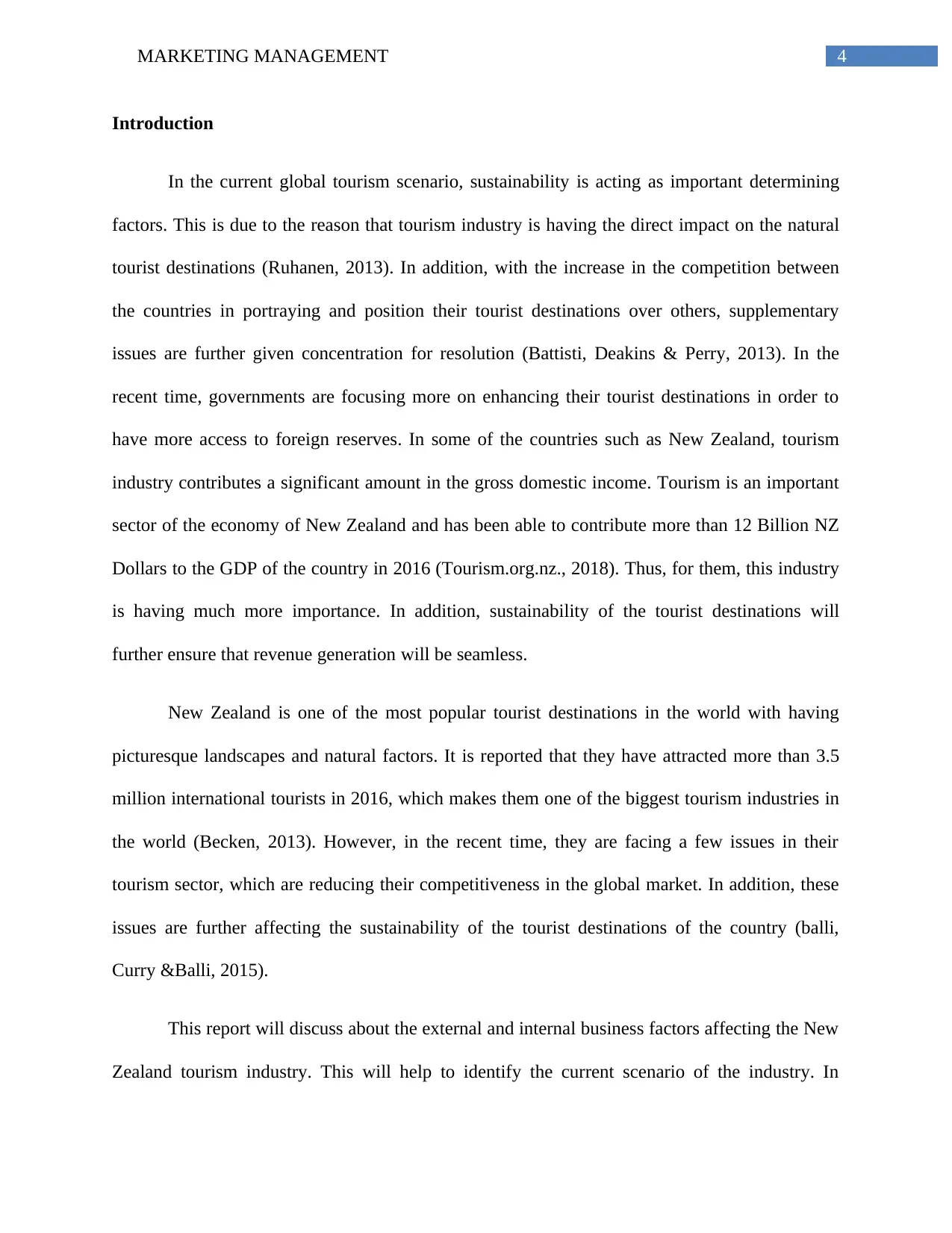
4MARKETING MANAGEMENT
Introduction
In the current global tourism scenario, sustainability is acting as important determining
factors. This is due to the reason that tourism industry is having the direct impact on the natural
tourist destinations (Ruhanen, 2013). In addition, with the increase in the competition between
the countries in portraying and position their tourist destinations over others, supplementary
issues are further given concentration for resolution (Battisti, Deakins & Perry, 2013). In the
recent time, governments are focusing more on enhancing their tourist destinations in order to
have more access to foreign reserves. In some of the countries such as New Zealand, tourism
industry contributes a significant amount in the gross domestic income. Tourism is an important
sector of the economy of New Zealand and has been able to contribute more than 12 Billion NZ
Dollars to the GDP of the country in 2016 (Tourism.org.nz., 2018). Thus, for them, this industry
is having much more importance. In addition, sustainability of the tourist destinations will
further ensure that revenue generation will be seamless.
New Zealand is one of the most popular tourist destinations in the world with having
picturesque landscapes and natural factors. It is reported that they have attracted more than 3.5
million international tourists in 2016, which makes them one of the biggest tourism industries in
the world (Becken, 2013). However, in the recent time, they are facing a few issues in their
tourism sector, which are reducing their competitiveness in the global market. In addition, these
issues are further affecting the sustainability of the tourist destinations of the country (balli,
Curry &Balli, 2015).
This report will discuss about the external and internal business factors affecting the New
Zealand tourism industry. This will help to identify the current scenario of the industry. In
Introduction
In the current global tourism scenario, sustainability is acting as important determining
factors. This is due to the reason that tourism industry is having the direct impact on the natural
tourist destinations (Ruhanen, 2013). In addition, with the increase in the competition between
the countries in portraying and position their tourist destinations over others, supplementary
issues are further given concentration for resolution (Battisti, Deakins & Perry, 2013). In the
recent time, governments are focusing more on enhancing their tourist destinations in order to
have more access to foreign reserves. In some of the countries such as New Zealand, tourism
industry contributes a significant amount in the gross domestic income. Tourism is an important
sector of the economy of New Zealand and has been able to contribute more than 12 Billion NZ
Dollars to the GDP of the country in 2016 (Tourism.org.nz., 2018). Thus, for them, this industry
is having much more importance. In addition, sustainability of the tourist destinations will
further ensure that revenue generation will be seamless.
New Zealand is one of the most popular tourist destinations in the world with having
picturesque landscapes and natural factors. It is reported that they have attracted more than 3.5
million international tourists in 2016, which makes them one of the biggest tourism industries in
the world (Becken, 2013). However, in the recent time, they are facing a few issues in their
tourism sector, which are reducing their competitiveness in the global market. In addition, these
issues are further affecting the sustainability of the tourist destinations of the country (balli,
Curry &Balli, 2015).
This report will discuss about the external and internal business factors affecting the New
Zealand tourism industry. This will help to identify the current scenario of the industry. In
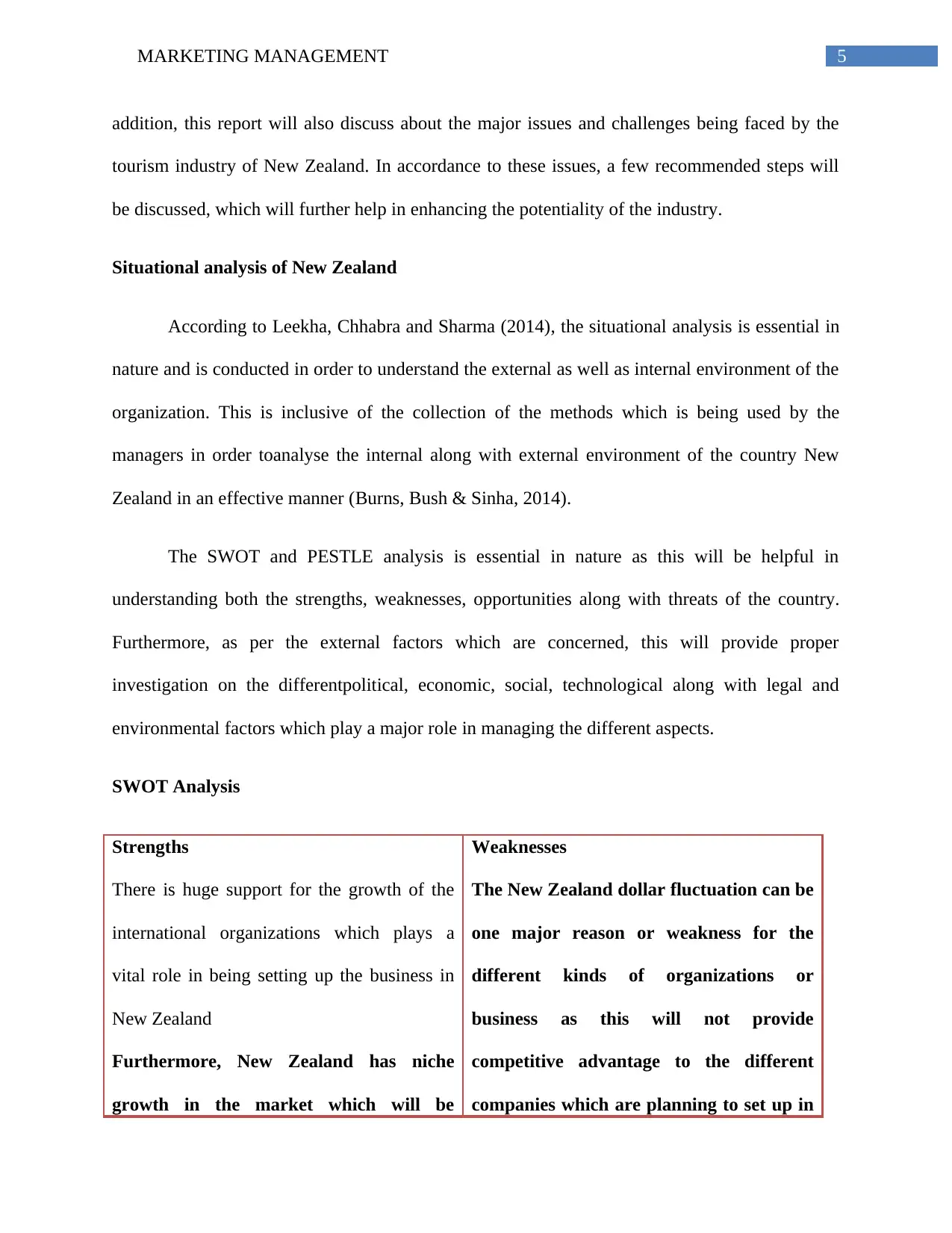
5MARKETING MANAGEMENT
addition, this report will also discuss about the major issues and challenges being faced by the
tourism industry of New Zealand. In accordance to these issues, a few recommended steps will
be discussed, which will further help in enhancing the potentiality of the industry.
Situational analysis of New Zealand
According to Leekha, Chhabra and Sharma (2014), the situational analysis is essential in
nature and is conducted in order to understand the external as well as internal environment of the
organization. This is inclusive of the collection of the methods which is being used by the
managers in order toanalyse the internal along with external environment of the country New
Zealand in an effective manner (Burns, Bush & Sinha, 2014).
The SWOT and PESTLE analysis is essential in nature as this will be helpful in
understanding both the strengths, weaknesses, opportunities along with threats of the country.
Furthermore, as per the external factors which are concerned, this will provide proper
investigation on the differentpolitical, economic, social, technological along with legal and
environmental factors which play a major role in managing the different aspects.
SWOT Analysis
Strengths
There is huge support for the growth of the
international organizations which plays a
vital role in being setting up the business in
New Zealand
Furthermore, New Zealand has niche
growth in the market which will be
Weaknesses
The New Zealand dollar fluctuation can be
one major reason or weakness for the
different kinds of organizations or
business as this will not provide
competitive advantage to the different
companies which are planning to set up in
addition, this report will also discuss about the major issues and challenges being faced by the
tourism industry of New Zealand. In accordance to these issues, a few recommended steps will
be discussed, which will further help in enhancing the potentiality of the industry.
Situational analysis of New Zealand
According to Leekha, Chhabra and Sharma (2014), the situational analysis is essential in
nature and is conducted in order to understand the external as well as internal environment of the
organization. This is inclusive of the collection of the methods which is being used by the
managers in order toanalyse the internal along with external environment of the country New
Zealand in an effective manner (Burns, Bush & Sinha, 2014).
The SWOT and PESTLE analysis is essential in nature as this will be helpful in
understanding both the strengths, weaknesses, opportunities along with threats of the country.
Furthermore, as per the external factors which are concerned, this will provide proper
investigation on the differentpolitical, economic, social, technological along with legal and
environmental factors which play a major role in managing the different aspects.
SWOT Analysis
Strengths
There is huge support for the growth of the
international organizations which plays a
vital role in being setting up the business in
New Zealand
Furthermore, New Zealand has niche
growth in the market which will be
Weaknesses
The New Zealand dollar fluctuation can be
one major reason or weakness for the
different kinds of organizations or
business as this will not provide
competitive advantage to the different
companies which are planning to set up in
⊘ This is a preview!⊘
Do you want full access?
Subscribe today to unlock all pages.

Trusted by 1+ million students worldwide
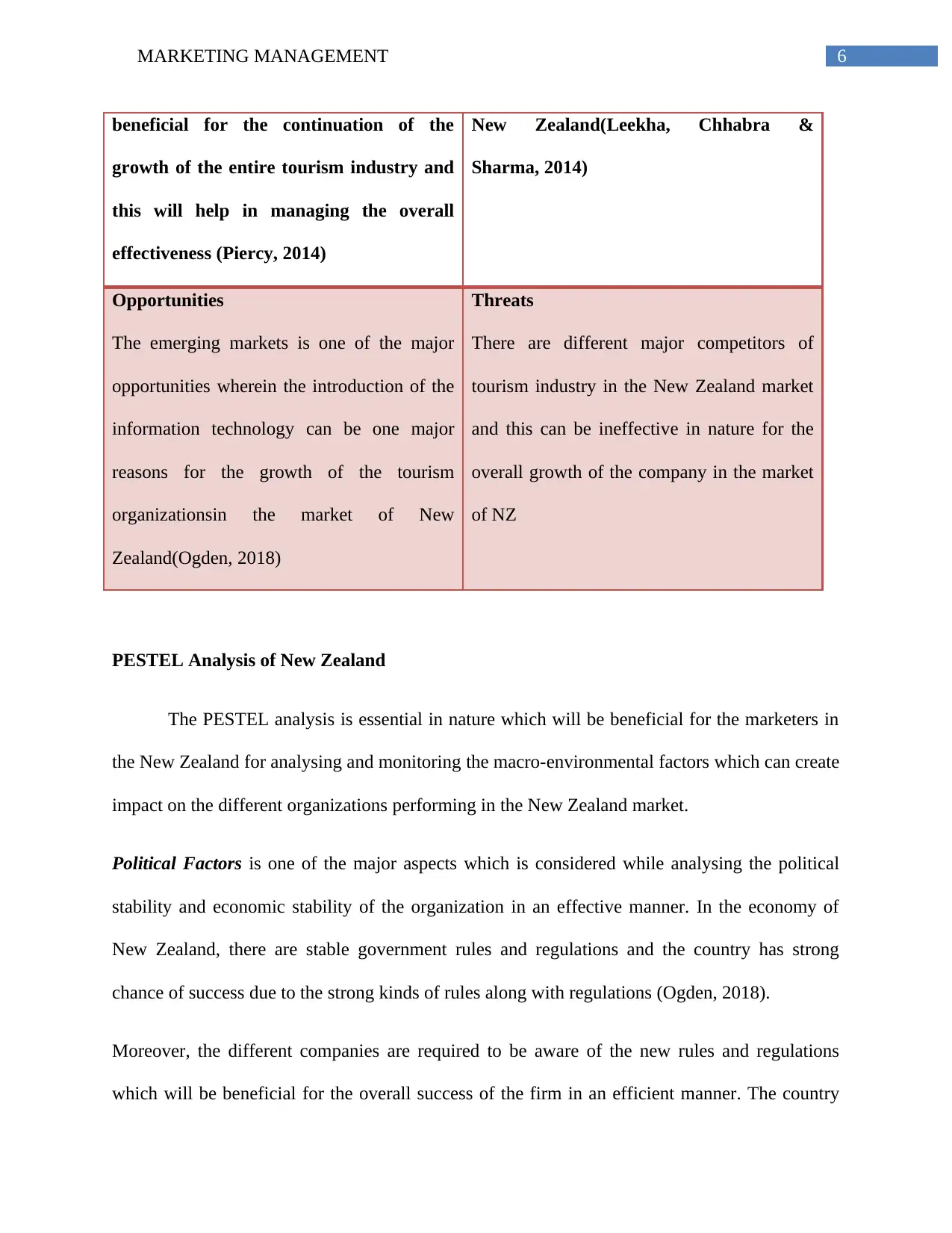
6MARKETING MANAGEMENT
beneficial for the continuation of the
growth of the entire tourism industry and
this will help in managing the overall
effectiveness (Piercy, 2014)
New Zealand(Leekha, Chhabra &
Sharma, 2014)
Opportunities
The emerging markets is one of the major
opportunities wherein the introduction of the
information technology can be one major
reasons for the growth of the tourism
organizationsin the market of New
Zealand(Ogden, 2018)
Threats
There are different major competitors of
tourism industry in the New Zealand market
and this can be ineffective in nature for the
overall growth of the company in the market
of NZ
PESTEL Analysis of New Zealand
The PESTEL analysis is essential in nature which will be beneficial for the marketers in
the New Zealand for analysing and monitoring the macro-environmental factors which can create
impact on the different organizations performing in the New Zealand market.
Political Factors is one of the major aspects which is considered while analysing the political
stability and economic stability of the organization in an effective manner. In the economy of
New Zealand, there are stable government rules and regulations and the country has strong
chance of success due to the strong kinds of rules along with regulations (Ogden, 2018).
Moreover, the different companies are required to be aware of the new rules and regulations
which will be beneficial for the overall success of the firm in an efficient manner. The country
beneficial for the continuation of the
growth of the entire tourism industry and
this will help in managing the overall
effectiveness (Piercy, 2014)
New Zealand(Leekha, Chhabra &
Sharma, 2014)
Opportunities
The emerging markets is one of the major
opportunities wherein the introduction of the
information technology can be one major
reasons for the growth of the tourism
organizationsin the market of New
Zealand(Ogden, 2018)
Threats
There are different major competitors of
tourism industry in the New Zealand market
and this can be ineffective in nature for the
overall growth of the company in the market
of NZ
PESTEL Analysis of New Zealand
The PESTEL analysis is essential in nature which will be beneficial for the marketers in
the New Zealand for analysing and monitoring the macro-environmental factors which can create
impact on the different organizations performing in the New Zealand market.
Political Factors is one of the major aspects which is considered while analysing the political
stability and economic stability of the organization in an effective manner. In the economy of
New Zealand, there are stable government rules and regulations and the country has strong
chance of success due to the strong kinds of rules along with regulations (Ogden, 2018).
Moreover, the different companies are required to be aware of the new rules and regulations
which will be beneficial for the overall success of the firm in an efficient manner. The country
Paraphrase This Document
Need a fresh take? Get an instant paraphrase of this document with our AI Paraphraser
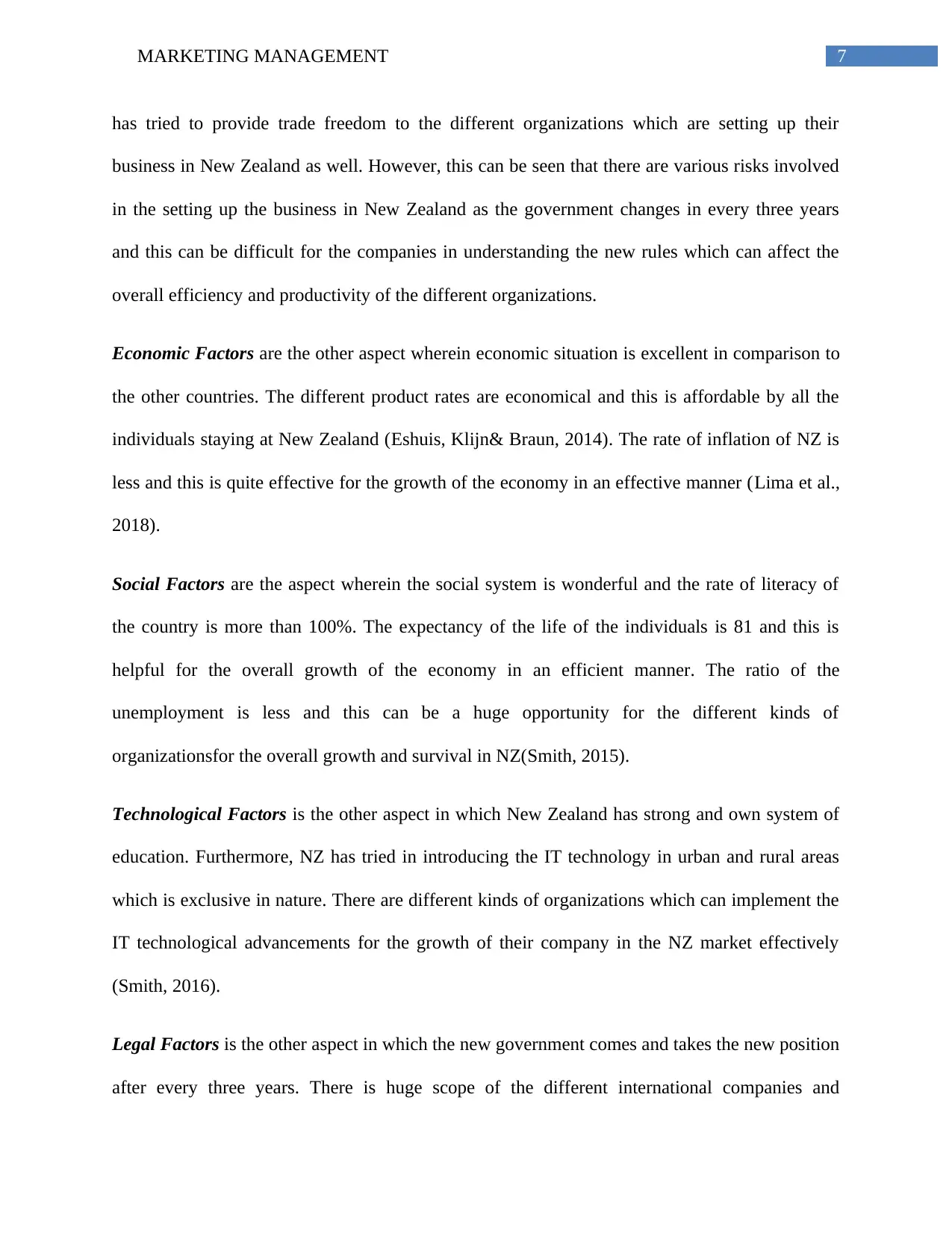
7MARKETING MANAGEMENT
has tried to provide trade freedom to the different organizations which are setting up their
business in New Zealand as well. However, this can be seen that there are various risks involved
in the setting up the business in New Zealand as the government changes in every three years
and this can be difficult for the companies in understanding the new rules which can affect the
overall efficiency and productivity of the different organizations.
Economic Factors are the other aspect wherein economic situation is excellent in comparison to
the other countries. The different product rates are economical and this is affordable by all the
individuals staying at New Zealand (Eshuis, Klijn& Braun, 2014). The rate of inflation of NZ is
less and this is quite effective for the growth of the economy in an effective manner (Lima et al.,
2018).
Social Factors are the aspect wherein the social system is wonderful and the rate of literacy of
the country is more than 100%. The expectancy of the life of the individuals is 81 and this is
helpful for the overall growth of the economy in an efficient manner. The ratio of the
unemployment is less and this can be a huge opportunity for the different kinds of
organizationsfor the overall growth and survival in NZ(Smith, 2015).
Technological Factors is the other aspect in which New Zealand has strong and own system of
education. Furthermore, NZ has tried in introducing the IT technology in urban and rural areas
which is exclusive in nature. There are different kinds of organizations which can implement the
IT technological advancements for the growth of their company in the NZ market effectively
(Smith, 2016).
Legal Factors is the other aspect in which the new government comes and takes the new position
after every three years. There is huge scope of the different international companies and
has tried to provide trade freedom to the different organizations which are setting up their
business in New Zealand as well. However, this can be seen that there are various risks involved
in the setting up the business in New Zealand as the government changes in every three years
and this can be difficult for the companies in understanding the new rules which can affect the
overall efficiency and productivity of the different organizations.
Economic Factors are the other aspect wherein economic situation is excellent in comparison to
the other countries. The different product rates are economical and this is affordable by all the
individuals staying at New Zealand (Eshuis, Klijn& Braun, 2014). The rate of inflation of NZ is
less and this is quite effective for the growth of the economy in an effective manner (Lima et al.,
2018).
Social Factors are the aspect wherein the social system is wonderful and the rate of literacy of
the country is more than 100%. The expectancy of the life of the individuals is 81 and this is
helpful for the overall growth of the economy in an efficient manner. The ratio of the
unemployment is less and this can be a huge opportunity for the different kinds of
organizationsfor the overall growth and survival in NZ(Smith, 2015).
Technological Factors is the other aspect in which New Zealand has strong and own system of
education. Furthermore, NZ has tried in introducing the IT technology in urban and rural areas
which is exclusive in nature. There are different kinds of organizations which can implement the
IT technological advancements for the growth of their company in the NZ market effectively
(Smith, 2016).
Legal Factors is the other aspect in which the new government comes and takes the new position
after every three years. There is huge scope of the different international companies and
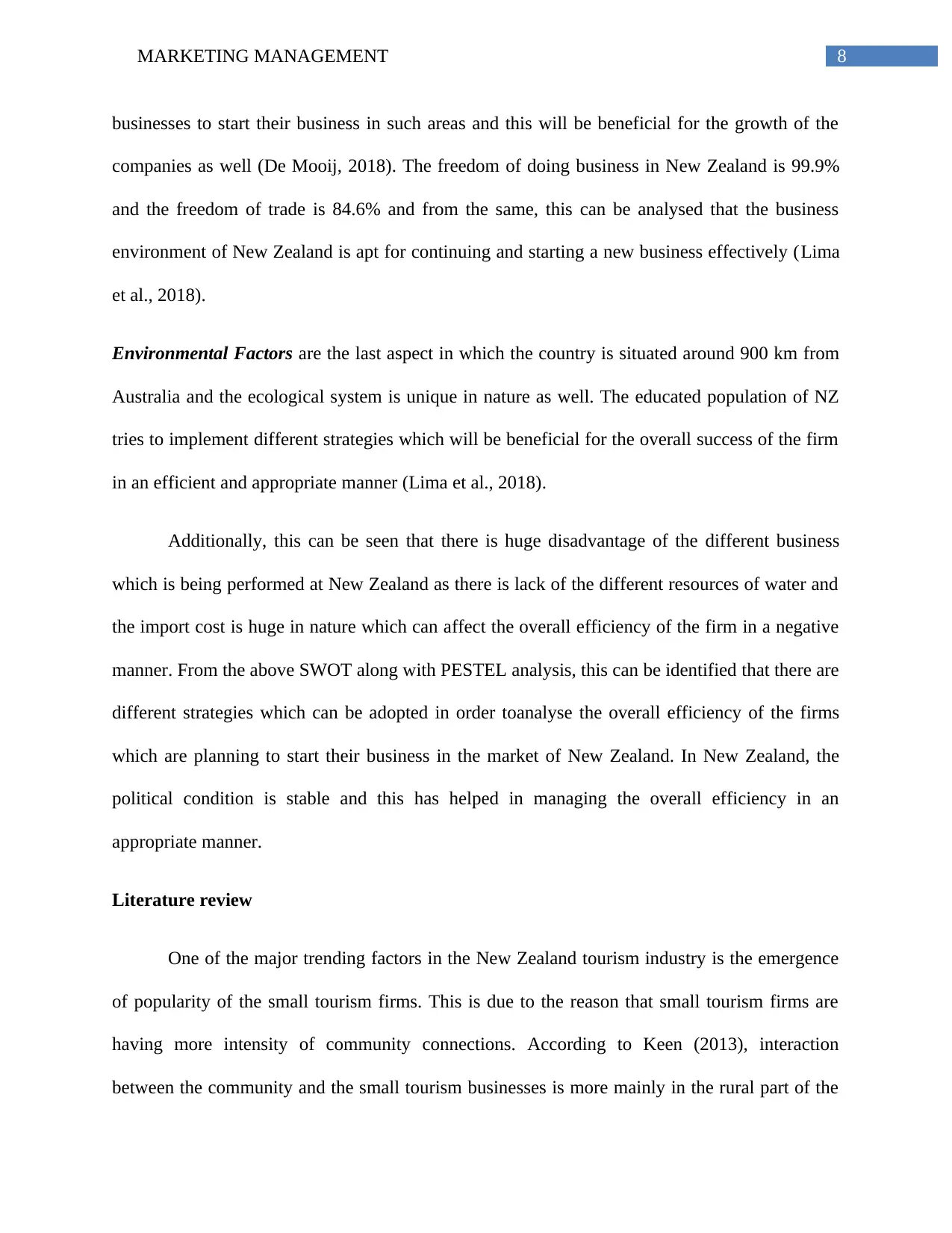
8MARKETING MANAGEMENT
businesses to start their business in such areas and this will be beneficial for the growth of the
companies as well (De Mooij, 2018). The freedom of doing business in New Zealand is 99.9%
and the freedom of trade is 84.6% and from the same, this can be analysed that the business
environment of New Zealand is apt for continuing and starting a new business effectively (Lima
et al., 2018).
Environmental Factors are the last aspect in which the country is situated around 900 km from
Australia and the ecological system is unique in nature as well. The educated population of NZ
tries to implement different strategies which will be beneficial for the overall success of the firm
in an efficient and appropriate manner (Lima et al., 2018).
Additionally, this can be seen that there is huge disadvantage of the different business
which is being performed at New Zealand as there is lack of the different resources of water and
the import cost is huge in nature which can affect the overall efficiency of the firm in a negative
manner. From the above SWOT along with PESTEL analysis, this can be identified that there are
different strategies which can be adopted in order toanalyse the overall efficiency of the firms
which are planning to start their business in the market of New Zealand. In New Zealand, the
political condition is stable and this has helped in managing the overall efficiency in an
appropriate manner.
Literature review
One of the major trending factors in the New Zealand tourism industry is the emergence
of popularity of the small tourism firms. This is due to the reason that small tourism firms are
having more intensity of community connections. According to Keen (2013), interaction
between the community and the small tourism businesses is more mainly in the rural part of the
businesses to start their business in such areas and this will be beneficial for the growth of the
companies as well (De Mooij, 2018). The freedom of doing business in New Zealand is 99.9%
and the freedom of trade is 84.6% and from the same, this can be analysed that the business
environment of New Zealand is apt for continuing and starting a new business effectively (Lima
et al., 2018).
Environmental Factors are the last aspect in which the country is situated around 900 km from
Australia and the ecological system is unique in nature as well. The educated population of NZ
tries to implement different strategies which will be beneficial for the overall success of the firm
in an efficient and appropriate manner (Lima et al., 2018).
Additionally, this can be seen that there is huge disadvantage of the different business
which is being performed at New Zealand as there is lack of the different resources of water and
the import cost is huge in nature which can affect the overall efficiency of the firm in a negative
manner. From the above SWOT along with PESTEL analysis, this can be identified that there are
different strategies which can be adopted in order toanalyse the overall efficiency of the firms
which are planning to start their business in the market of New Zealand. In New Zealand, the
political condition is stable and this has helped in managing the overall efficiency in an
appropriate manner.
Literature review
One of the major trending factors in the New Zealand tourism industry is the emergence
of popularity of the small tourism firms. This is due to the reason that small tourism firms are
having more intensity of community connections. According to Keen (2013), interaction
between the community and the small tourism businesses is more mainly in the rural part of the
⊘ This is a preview!⊘
Do you want full access?
Subscribe today to unlock all pages.

Trusted by 1+ million students worldwide
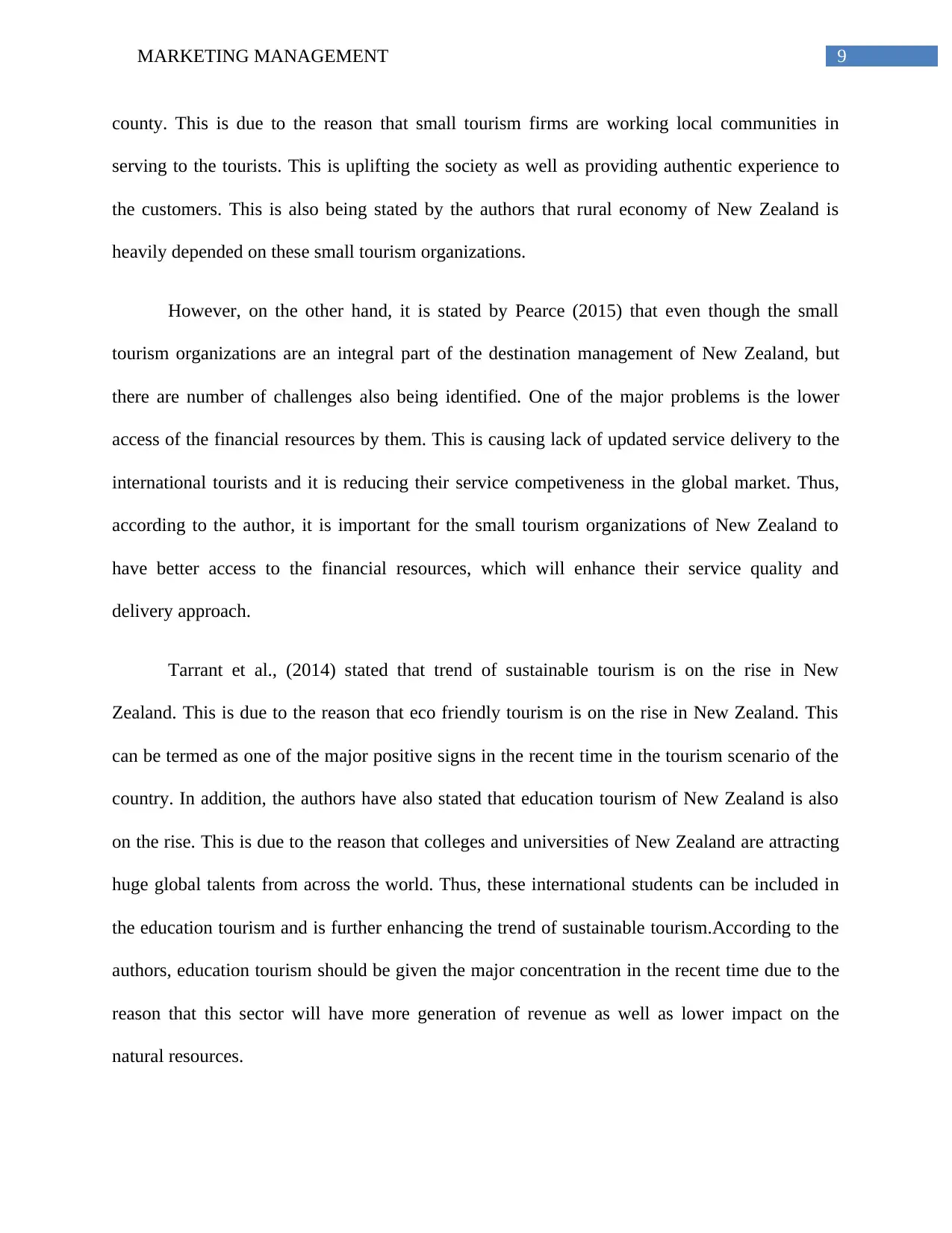
9MARKETING MANAGEMENT
county. This is due to the reason that small tourism firms are working local communities in
serving to the tourists. This is uplifting the society as well as providing authentic experience to
the customers. This is also being stated by the authors that rural economy of New Zealand is
heavily depended on these small tourism organizations.
However, on the other hand, it is stated by Pearce (2015) that even though the small
tourism organizations are an integral part of the destination management of New Zealand, but
there are number of challenges also being identified. One of the major problems is the lower
access of the financial resources by them. This is causing lack of updated service delivery to the
international tourists and it is reducing their service competiveness in the global market. Thus,
according to the author, it is important for the small tourism organizations of New Zealand to
have better access to the financial resources, which will enhance their service quality and
delivery approach.
Tarrant et al., (2014) stated that trend of sustainable tourism is on the rise in New
Zealand. This is due to the reason that eco friendly tourism is on the rise in New Zealand. This
can be termed as one of the major positive signs in the recent time in the tourism scenario of the
country. In addition, the authors have also stated that education tourism of New Zealand is also
on the rise. This is due to the reason that colleges and universities of New Zealand are attracting
huge global talents from across the world. Thus, these international students can be included in
the education tourism and is further enhancing the trend of sustainable tourism.According to the
authors, education tourism should be given the major concentration in the recent time due to the
reason that this sector will have more generation of revenue as well as lower impact on the
natural resources.
county. This is due to the reason that small tourism firms are working local communities in
serving to the tourists. This is uplifting the society as well as providing authentic experience to
the customers. This is also being stated by the authors that rural economy of New Zealand is
heavily depended on these small tourism organizations.
However, on the other hand, it is stated by Pearce (2015) that even though the small
tourism organizations are an integral part of the destination management of New Zealand, but
there are number of challenges also being identified. One of the major problems is the lower
access of the financial resources by them. This is causing lack of updated service delivery to the
international tourists and it is reducing their service competiveness in the global market. Thus,
according to the author, it is important for the small tourism organizations of New Zealand to
have better access to the financial resources, which will enhance their service quality and
delivery approach.
Tarrant et al., (2014) stated that trend of sustainable tourism is on the rise in New
Zealand. This is due to the reason that eco friendly tourism is on the rise in New Zealand. This
can be termed as one of the major positive signs in the recent time in the tourism scenario of the
country. In addition, the authors have also stated that education tourism of New Zealand is also
on the rise. This is due to the reason that colleges and universities of New Zealand are attracting
huge global talents from across the world. Thus, these international students can be included in
the education tourism and is further enhancing the trend of sustainable tourism.According to the
authors, education tourism should be given the major concentration in the recent time due to the
reason that this sector will have more generation of revenue as well as lower impact on the
natural resources.
Paraphrase This Document
Need a fresh take? Get an instant paraphrase of this document with our AI Paraphraser
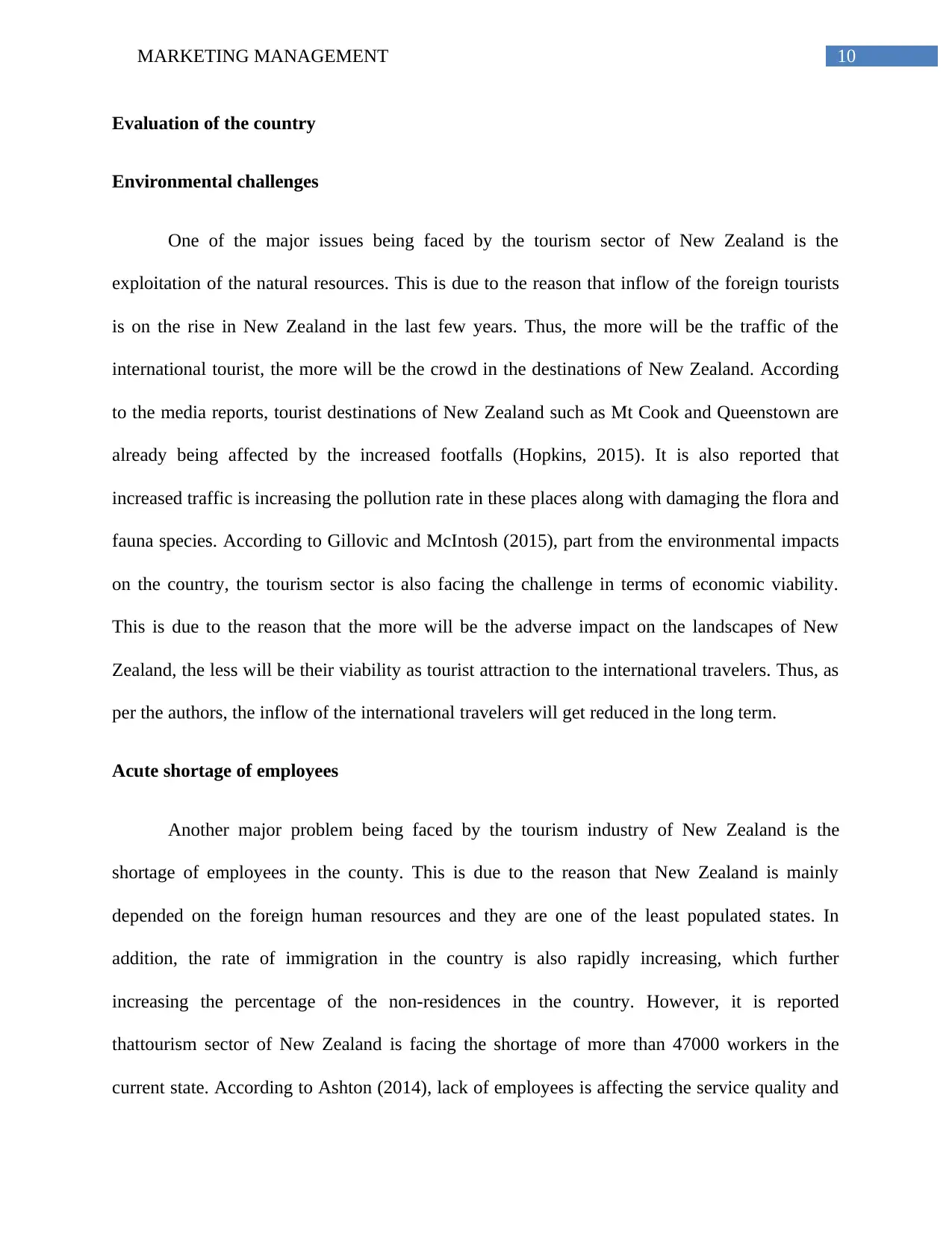
10MARKETING MANAGEMENT
Evaluation of the country
Environmental challenges
One of the major issues being faced by the tourism sector of New Zealand is the
exploitation of the natural resources. This is due to the reason that inflow of the foreign tourists
is on the rise in New Zealand in the last few years. Thus, the more will be the traffic of the
international tourist, the more will be the crowd in the destinations of New Zealand. According
to the media reports, tourist destinations of New Zealand such as Mt Cook and Queenstown are
already being affected by the increased footfalls (Hopkins, 2015). It is also reported that
increased traffic is increasing the pollution rate in these places along with damaging the flora and
fauna species. According to Gillovic and McIntosh (2015), part from the environmental impacts
on the country, the tourism sector is also facing the challenge in terms of economic viability.
This is due to the reason that the more will be the adverse impact on the landscapes of New
Zealand, the less will be their viability as tourist attraction to the international travelers. Thus, as
per the authors, the inflow of the international travelers will get reduced in the long term.
Acute shortage of employees
Another major problem being faced by the tourism industry of New Zealand is the
shortage of employees in the county. This is due to the reason that New Zealand is mainly
depended on the foreign human resources and they are one of the least populated states. In
addition, the rate of immigration in the country is also rapidly increasing, which further
increasing the percentage of the non-residences in the country. However, it is reported
thattourism sector of New Zealand is facing the shortage of more than 47000 workers in the
current state. According to Ashton (2014), lack of employees is affecting the service quality and
Evaluation of the country
Environmental challenges
One of the major issues being faced by the tourism sector of New Zealand is the
exploitation of the natural resources. This is due to the reason that inflow of the foreign tourists
is on the rise in New Zealand in the last few years. Thus, the more will be the traffic of the
international tourist, the more will be the crowd in the destinations of New Zealand. According
to the media reports, tourist destinations of New Zealand such as Mt Cook and Queenstown are
already being affected by the increased footfalls (Hopkins, 2015). It is also reported that
increased traffic is increasing the pollution rate in these places along with damaging the flora and
fauna species. According to Gillovic and McIntosh (2015), part from the environmental impacts
on the country, the tourism sector is also facing the challenge in terms of economic viability.
This is due to the reason that the more will be the adverse impact on the landscapes of New
Zealand, the less will be their viability as tourist attraction to the international travelers. Thus, as
per the authors, the inflow of the international travelers will get reduced in the long term.
Acute shortage of employees
Another major problem being faced by the tourism industry of New Zealand is the
shortage of employees in the county. This is due to the reason that New Zealand is mainly
depended on the foreign human resources and they are one of the least populated states. In
addition, the rate of immigration in the country is also rapidly increasing, which further
increasing the percentage of the non-residences in the country. However, it is reported
thattourism sector of New Zealand is facing the shortage of more than 47000 workers in the
current state. According to Ashton (2014), lack of employees is affecting the service quality and
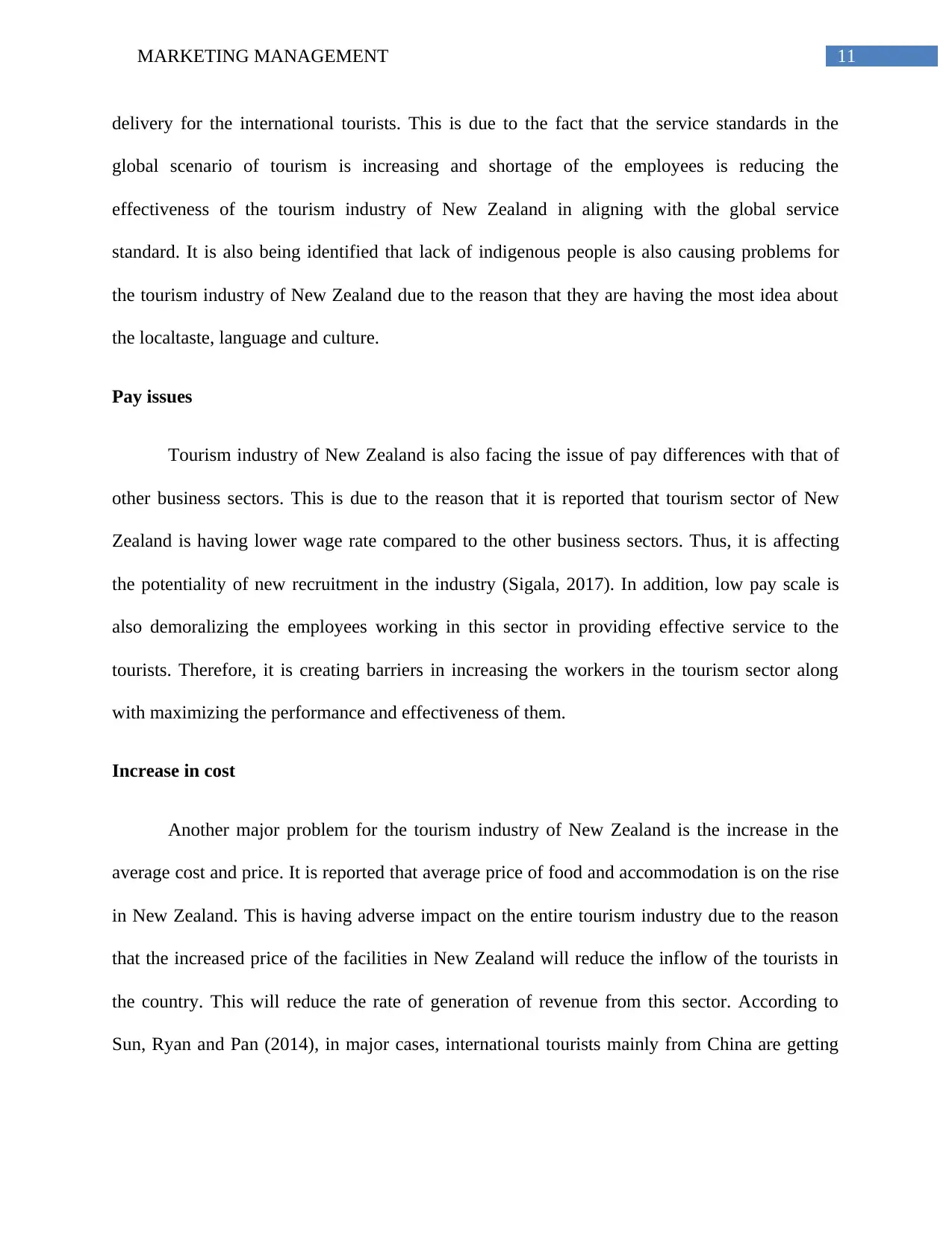
11MARKETING MANAGEMENT
delivery for the international tourists. This is due to the fact that the service standards in the
global scenario of tourism is increasing and shortage of the employees is reducing the
effectiveness of the tourism industry of New Zealand in aligning with the global service
standard. It is also being identified that lack of indigenous people is also causing problems for
the tourism industry of New Zealand due to the reason that they are having the most idea about
the localtaste, language and culture.
Pay issues
Tourism industry of New Zealand is also facing the issue of pay differences with that of
other business sectors. This is due to the reason that it is reported that tourism sector of New
Zealand is having lower wage rate compared to the other business sectors. Thus, it is affecting
the potentiality of new recruitment in the industry (Sigala, 2017). In addition, low pay scale is
also demoralizing the employees working in this sector in providing effective service to the
tourists. Therefore, it is creating barriers in increasing the workers in the tourism sector along
with maximizing the performance and effectiveness of them.
Increase in cost
Another major problem for the tourism industry of New Zealand is the increase in the
average cost and price. It is reported that average price of food and accommodation is on the rise
in New Zealand. This is having adverse impact on the entire tourism industry due to the reason
that the increased price of the facilities in New Zealand will reduce the inflow of the tourists in
the country. This will reduce the rate of generation of revenue from this sector. According to
Sun, Ryan and Pan (2014), in major cases, international tourists mainly from China are getting
delivery for the international tourists. This is due to the fact that the service standards in the
global scenario of tourism is increasing and shortage of the employees is reducing the
effectiveness of the tourism industry of New Zealand in aligning with the global service
standard. It is also being identified that lack of indigenous people is also causing problems for
the tourism industry of New Zealand due to the reason that they are having the most idea about
the localtaste, language and culture.
Pay issues
Tourism industry of New Zealand is also facing the issue of pay differences with that of
other business sectors. This is due to the reason that it is reported that tourism sector of New
Zealand is having lower wage rate compared to the other business sectors. Thus, it is affecting
the potentiality of new recruitment in the industry (Sigala, 2017). In addition, low pay scale is
also demoralizing the employees working in this sector in providing effective service to the
tourists. Therefore, it is creating barriers in increasing the workers in the tourism sector along
with maximizing the performance and effectiveness of them.
Increase in cost
Another major problem for the tourism industry of New Zealand is the increase in the
average cost and price. It is reported that average price of food and accommodation is on the rise
in New Zealand. This is having adverse impact on the entire tourism industry due to the reason
that the increased price of the facilities in New Zealand will reduce the inflow of the tourists in
the country. This will reduce the rate of generation of revenue from this sector. According to
Sun, Ryan and Pan (2014), in major cases, international tourists mainly from China are getting
⊘ This is a preview!⊘
Do you want full access?
Subscribe today to unlock all pages.

Trusted by 1+ million students worldwide
1 out of 23
Related Documents
Your All-in-One AI-Powered Toolkit for Academic Success.
+13062052269
info@desklib.com
Available 24*7 on WhatsApp / Email
![[object Object]](/_next/static/media/star-bottom.7253800d.svg)
Unlock your academic potential
Copyright © 2020–2025 A2Z Services. All Rights Reserved. Developed and managed by ZUCOL.




